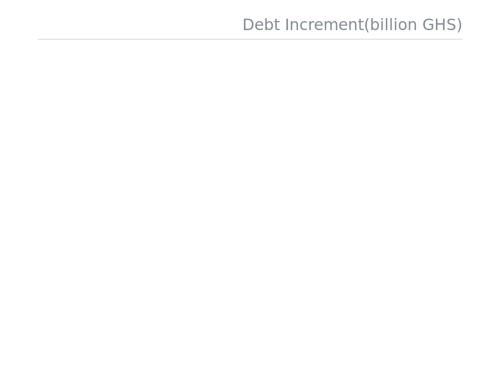May 8, 2023

There has been a longstanding public debate about who has borrowed more between Ghana’s two main political parties, National Democratic Congress (NDC) and the New Patriotic Party (NPP).
In the country’s Fourth Republic, which began in 1993, the National Democratic Congress (NDC) and the New Patriotic Party (NPP) have taken turns in power, serving two terms of eight years each. During their respective tenures, both governments borrowed to finance different projects. President J. A Kufuor’s administration was the first to explore financing options beyond bilateral and multilateral loans, venturing into the Eurobond market.
It must be pointed out that Kufuor’s government had the benefit of debt cancelation to cushion it as part of the Highly Indebted Poor Countries (HIPC) Initiative. The country benefited from a $3.7 billion International Monetary Fund (IMF) and World Bank debt relief which meant funds that would have gone into payment of interests were available to the government. It could therefore account for the government borrowing less.
Recently, Stephen Ntim, the Chairman of the New Patriotic Party, criticized the National Democratic Congress for providing misinformation on Ghana’s debt situation by using nominal figures. According to Mr. Ntim, relying on nominal figures hides the NDC’s unprecedented rate of debt accumulation during its tenure in power.
He alleged that the country’s largest opposition party had raised the country’s debt stock by 819% between 2009 and 2016, from GHc 9.7 billion to GHc 122 billion. However, he did not mention the current debt stock of the country, but he did state that the Akufo-Addo administration was responsible for only a 304% increase in the total accumulated debt and attributed the increment to expenses such as the banking sector cleanup, energy sector debt payment, and Covid-19 debt.
Ahead of the 2020 elections, the National Democratic Congress also accused the Akufo-Addo government of borrowing more than any government in the history of Ghana.
“In the year 2016, our public debt stood at GHS120 billion and our debt to GDP ratio at 55.6% (rebased economic data). But what do we see today? Our Public debt which stood at GHS120 billion as of December 2016, has ballooned to GHS258.8 billion, (i.e. as of June 2020). Also, our debt to GDP ratio which stood at 55.6% as of December 2016, has increased to 68.3% and is projected by the IMF to hit 76.7% by December this year,” the party’s National Communications Officer, Sammy Gyamfi, said.
In this report, Fact-Check Ghana presents the data on how much each government has borrowed in the last ten years.
Comparing the chart above, it will be noted that the country’s total debt stock increased about twice the figure from 2011-2021 causing Ghana to face a high risk of debt distress. This has increased the country’s overall debt vulnerability.
Within eight years (2008 – 2016) under the late John Evans Atta Mills and John Mahama’s leadership, the country borrowed GHS112, 426.14 billion.
Mahama’s share of the debt during his tenure was GHS 86,263.4 billion cedis.
When Nana Akufo-Addo took over in 2017, his government passed the Fiscal Responsibility Act to keep the country’s debt at sustainable levels. But the Act would amount to little or nothing, as the government rather added to the rising debt stock.
Below is the data representation of how much each government has added to Ghana’s debt stock over the years:

In five years, the Nana Addo-led government has added over 400 billion cedis to the country’s debt stock. This is twice more than the debt that the John Mahama-led NDC incurred in nominal terms.
According to the 2021 annual debt management report by Ghana’s Ministry of Finance, the rise in the debt stock in 2021 was partly due to the financial sector clean-up costs, energy sector payments, and COVID-19-related expenditures. Additionally, the financial sector clean-up in 2021 cost the public purse GHS 25 billion cedis.
With domestic revenue failing to match with expenditure, the country has been struggling to meet its debt obligations. This resulted in the “big three” credit rating agencies – Fitch, Moody’s, and Standard & Poor’s – downgrading Ghana’s creditworthiness to junk levels. The scorecards of these agencies help investors and other interested parties to assess the creditworthiness of an entity and its ability to repay its debt obligations.
In December 2022, the Ministry of Finance announced the suspension of payments on a significant portion of its external debt, which is effectively a default, due to the country’s difficulties in addressing its substantial balance of payments deficit. The finance ministry declared that it will not be able to service its Eurobonds, commercial loans, and the majority of its bilateral loans. The decision was referred to as an “interim emergency measure.”
It has since implemented a controversial Domestic Debt Exchange Programme which ended in February. The government is currently negotiating with its external creditors, as it awaits a $3 billion International Monetary Fund (IMF) bailout.
Why using only percentages or nominal figures could be deceptive in debt analysis
Experts say relying solely on percentages or nominal figures when doing debt analysis can be deceptive and lead to a misunderstanding of the actual level of indebtedness. Percentages can be misleading because they do not necessarily reflect the total amount of debt or the ability to service it.
Similarly, nominal figures can be deceptive because they do not account for inflation or changes in currency value. For instance, a country may have high debt in nominal terms, but if inflation is high, the real value of the debt may be lower. On the other hand, a country with a low nominal debt may still struggle to service it if the value of its currency decreases.
To avoid being misled by percentages and nominal figures, experts’ advice that a more comprehensive debt analysis should be conducted. This includes looking at the absolute level of debt, debt sustainability, and debt serviceability. Debt sustainability involves analyzing a country’s ability to manage its current debt and avoid default, while debt serviceability involves examining its capacity to make timely payments on its debt obligations.




